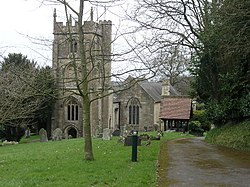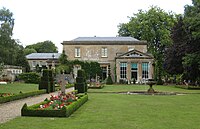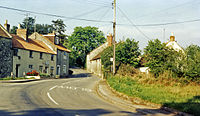Camerton, Somerset
| Camerton | |
| Somerset | |
|---|---|
 Church of St Peter, Camerton Park | |
| Location | |
| Grid reference: | ST685578 |
| Location: | 51°19’8"N, 2°27’9"W |
| Data | |
| Population: | 655 (2011) |
| Post town: | Bath |
| Postcode: | BA2 |
| Dialling code: | 01761 |
| Local Government | |
| Council: | Bath & NE Somerset |
| Parliamentary constituency: |
North East Somerset |
Camerton is a village in Somerset, six miles south-west of Bath, lying on the Cam Brook. It is within the Wellow Hundred in the north of the county.[1]
The parish has a population of 655.
History
The parish includes the hamlet of Tunley, which is the site of a hill fort that has been designated as a Scheduled Ancient Monument.[2]
The village stands beside the route of the Fosse Way, and a Roman settlement was south-west of the current village.[3][4]

Originally a farming village in North Somerset, its vicar from 1800 was the amateur antiquarian and archaeologist The Rev. John Skinner, who committed suicide in 1839. Camerton Court was built by the Jarrett family,[5] to a design by George Repton (son of Humphry Repton), in 1838-40, replacing an earlier Manor House.[6]
The village expanded as a result of coal mining on the Somerset coalfield in the 19th century. Camerton New Colliery, which started in the very early 19th century, and Camerton Old Colliery, which predates it by about 20 years. Camerton New Pit survived to be nationalised, eventually closing in 1950. The maximum amount mined was 77,000 tons in 1903. In the centre of the village is an old coal spoil tip or "batch" called Camerton Batch (or Camerton Old Batch to distinguish it from the taller Camerton New Batch which lies just to the east). Camerton Batch was designated as a Local Nature Reserve in 1997.[7]
With the closure of the coal mines it is now primarily a commuter village for people working in Bristol or Bath. Camerton is also home to the National Osteoporosis Society.
In 2007 Camerton was the site of a prosecution by the Environment Agency for the illegal dumping of waste including concrete, tarmac, bricks, blocks, subsoil, metal, fluorescent light tubes, electrical cable and asbestos sheets on the site.[8]
Transport links

Camerton once had a branch line from the Bristol and North Somerset Railway (part of the Great Western Railway) mainly for coal. It opened from Hallatrow in 1882 and was extended along the line of the former Somerset Coal Canal to Limpley Stoke in 1910, where it joined with the main line from Bath to Bradford-on-Avon. Traffic on the line was never heavy: passenger services were suspended in 1915, resumed in 1923 and finally withdrawn in 1925. Goods traffic remained until 1951.
The Titfield Thunderbolt was filmed on the line shortly after it closed.
Parish church
The parish church, St Peter, dates from the 15th century with addition and renovation in 1638 and again in 1891. It is a Grade I listed building.[9] From 1800 to 1839 the vicar was the archaeologist John Skinner.[10] The grave of Sir Frank Beauchamp who owned many coalmines in the area is in the churchyard.
Outside links
| ("Wikimedia Commons" has material about Camerton, Somerset) |
References
- ↑ "Somerset Hundreds". GENUKI. http://www.genuki.org.uk/big/eng/SOM/Miscellaneous/. Retrieved 22 October 2011.
- ↑ "Scheduled Monuments in Bath & North East Somerset". Bath and North East Somerset. Archived from the original on 8 April 2008. https://web.archive.org/web/20080408161446/http://www.bathnes.gov.uk/BathNES/environmentandplanning/Archaeology/ListOfScheduledMonuments.htm. Retrieved 2008-08-14.
- ↑ Scott, Shane (1995). The hidden places of Somerset. Aldermaston: Travel Publishing Ltd. p. 22. ISBN 1-902007-01-8.
- ↑ Havinden, Michael (1981). The Somerset Landscape. The making of the English landscape. London: Hodder and Stoughton Ltd. p. 69. ISBN 0-340-20116-9.
- ↑ "Orange Tree Valley". http://www.orange-tree-valley.co.uk/hnj/rr01/rr01_016.htm#P416. Retrieved 2008-12-04.
- ↑ National Heritage List 1365682: Camerton Court
- ↑ "Camerton Batch". Natural England. http://www.lnr.naturalengland.org.uk/special/lnr/lnr_details.asp?themeid=1009314. Retrieved 2 January 2011.
- ↑ "Three fined for dumping waste near an ancient monument at Bath". Environment Agency. http://www.stonepages.com/news/archives/002507.html. Retrieved 2010-11-09.
- ↑ National Heritage List 1129514: Church of St. Peter
- ↑ Thomas, Rod (2008). A Sacred landscape: The prehistory of Bathampton Down. Bath: Millstream Books. pp. 58–59. ISBN 978-0-948975-86-8.
